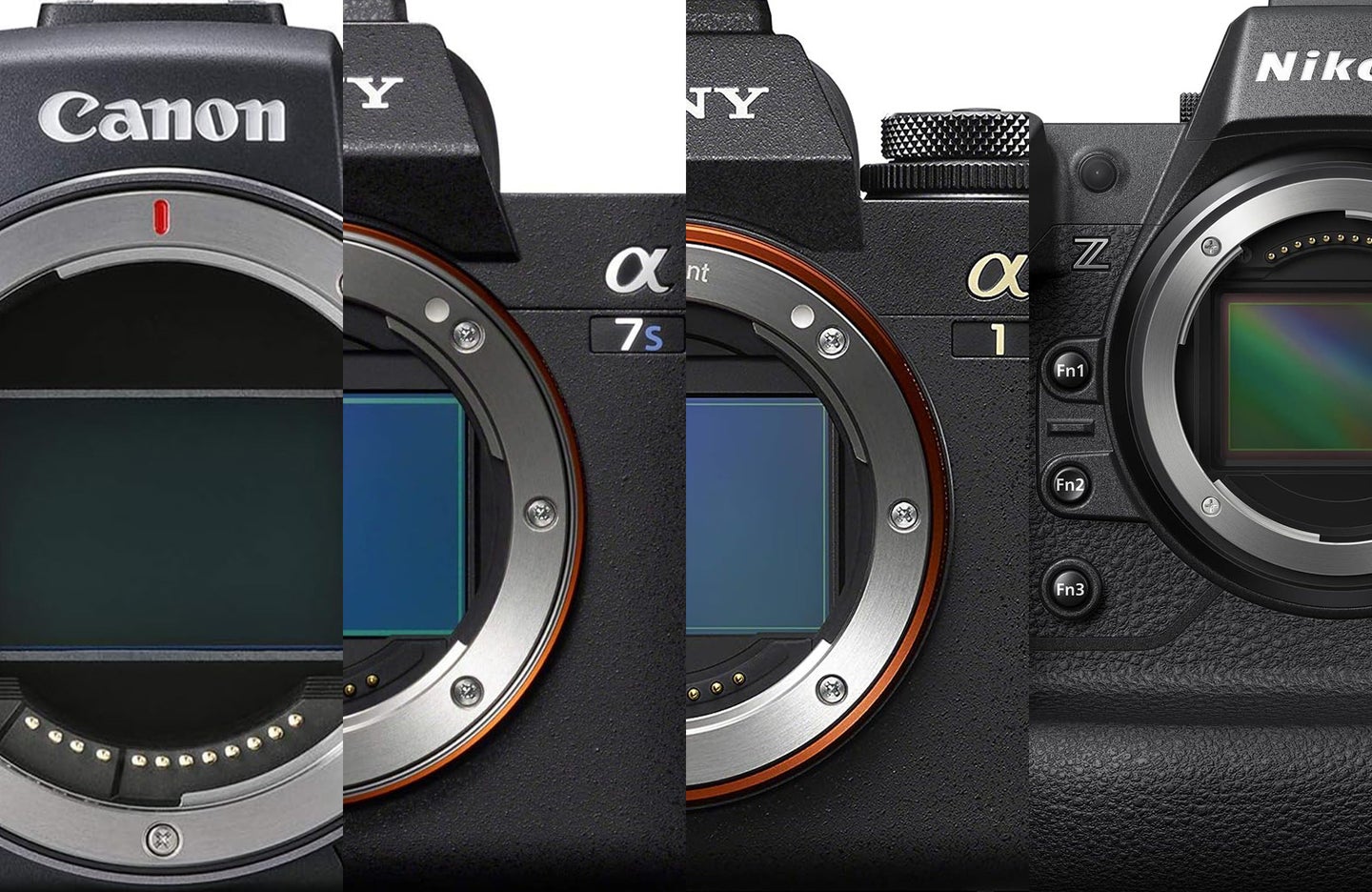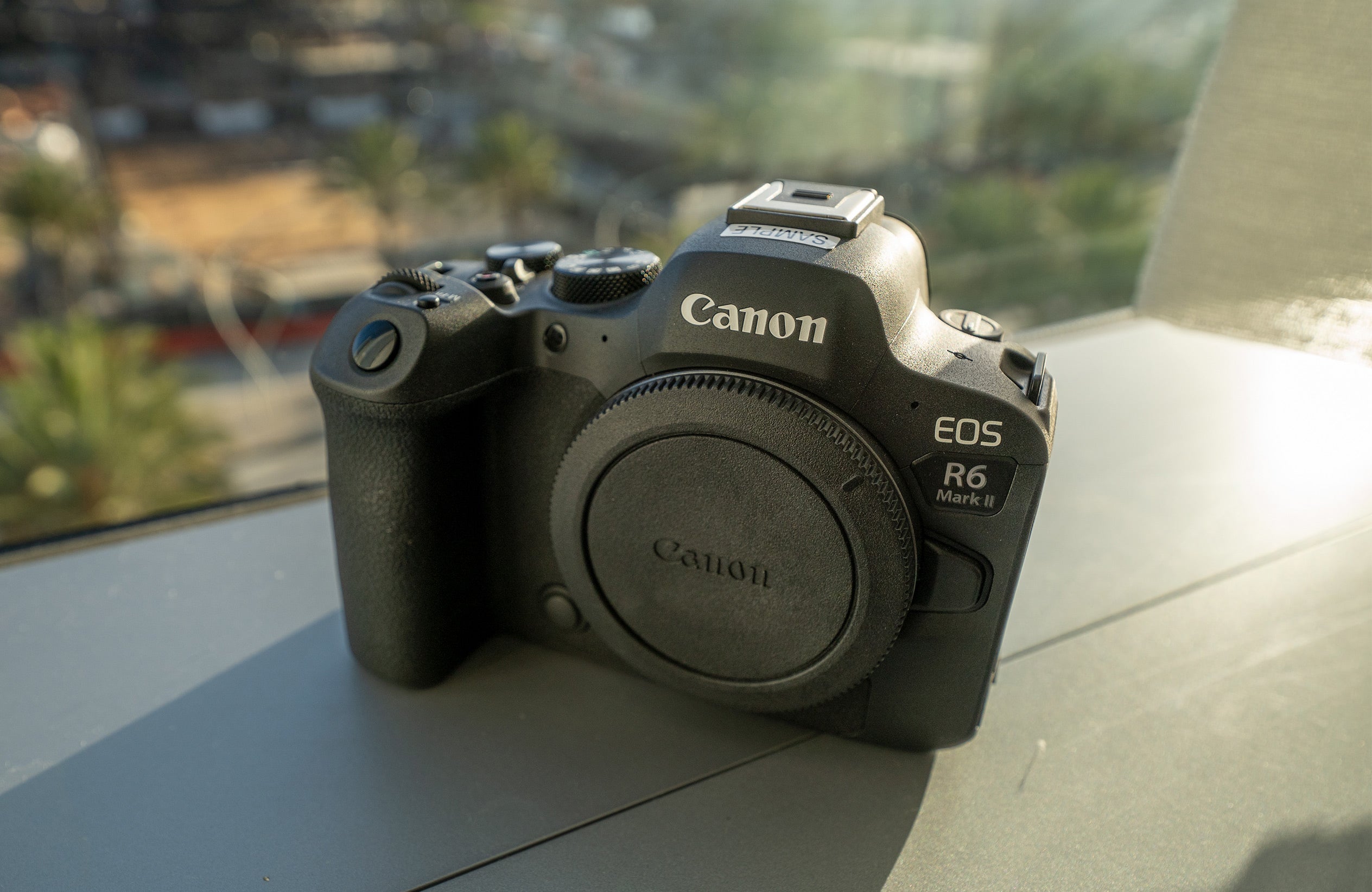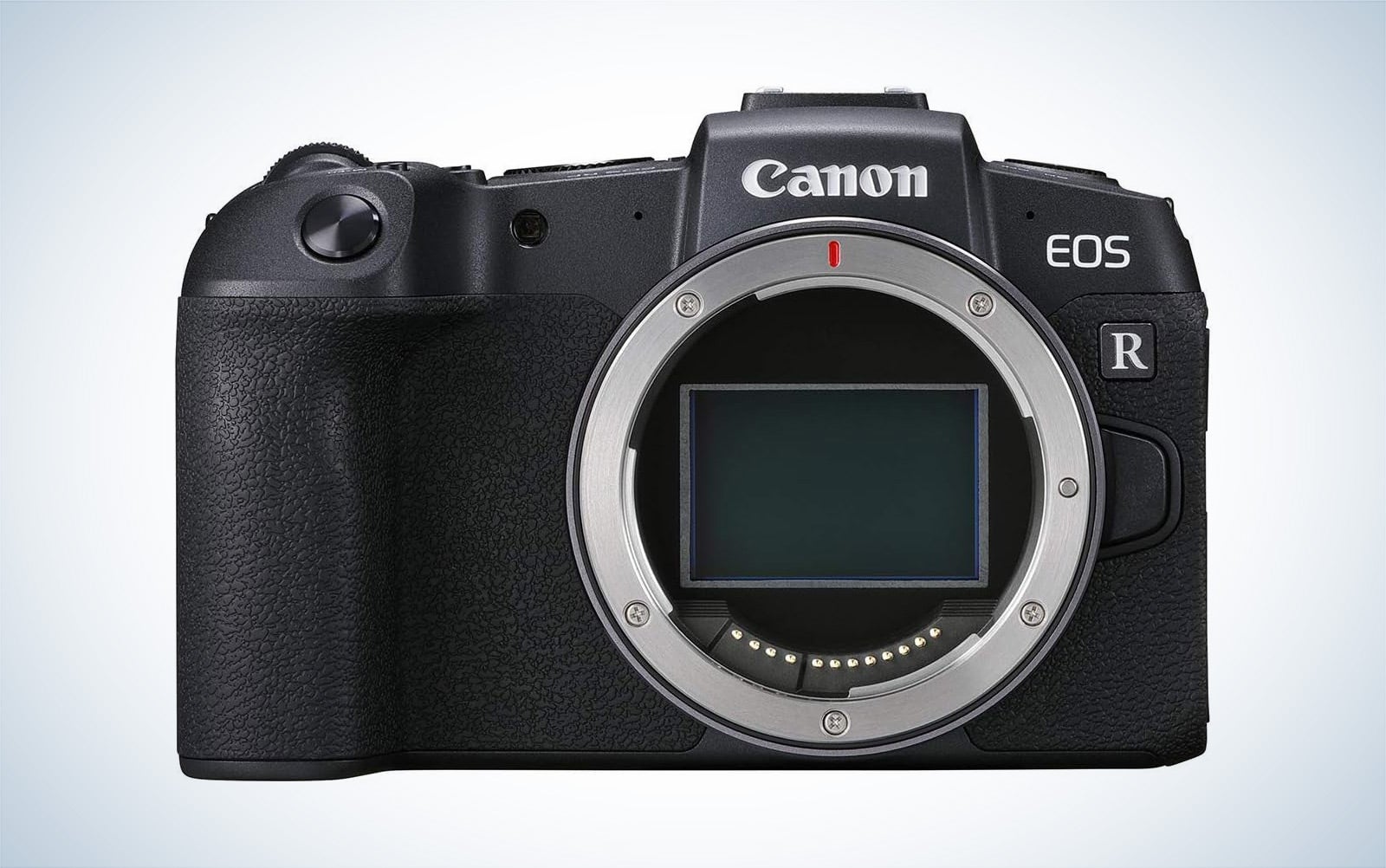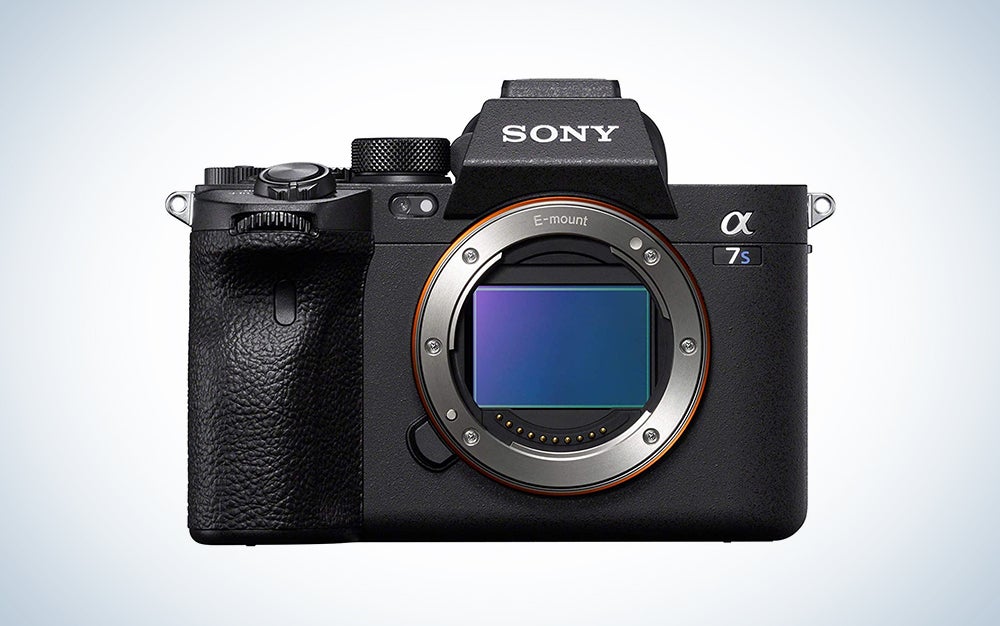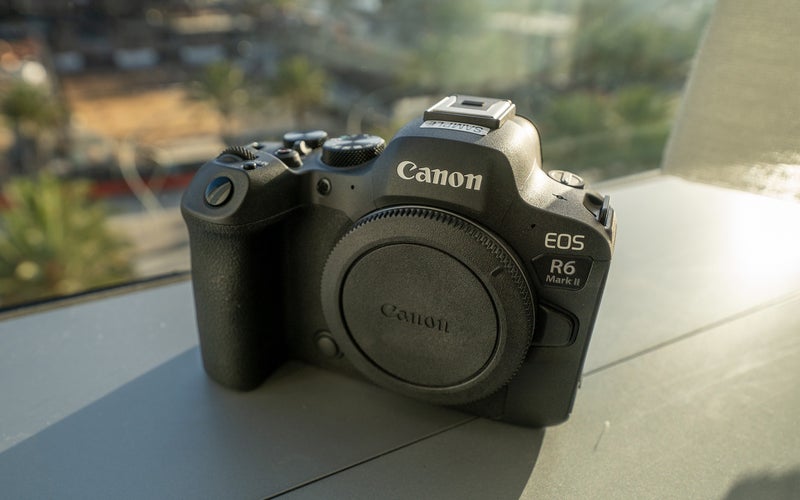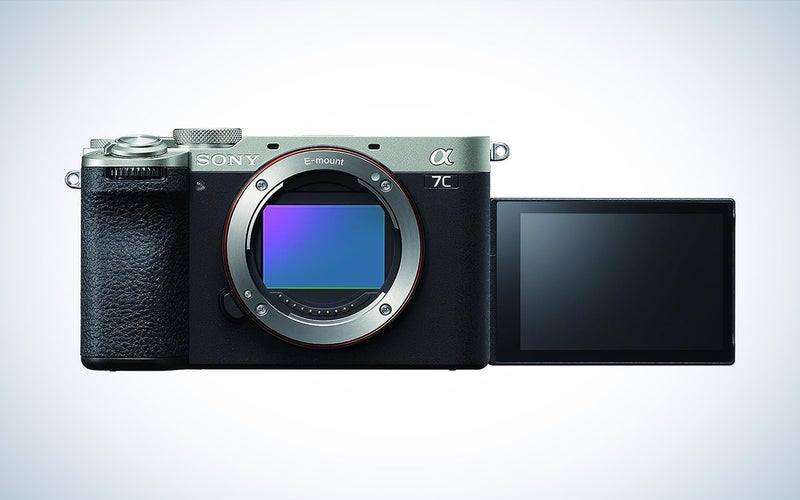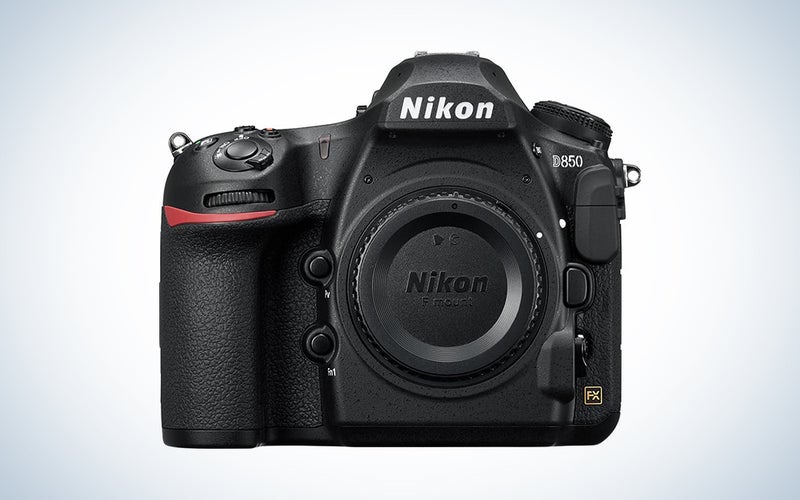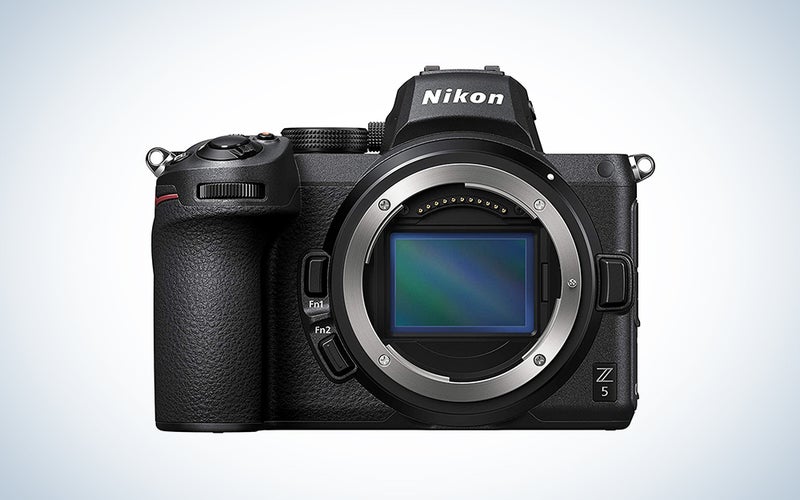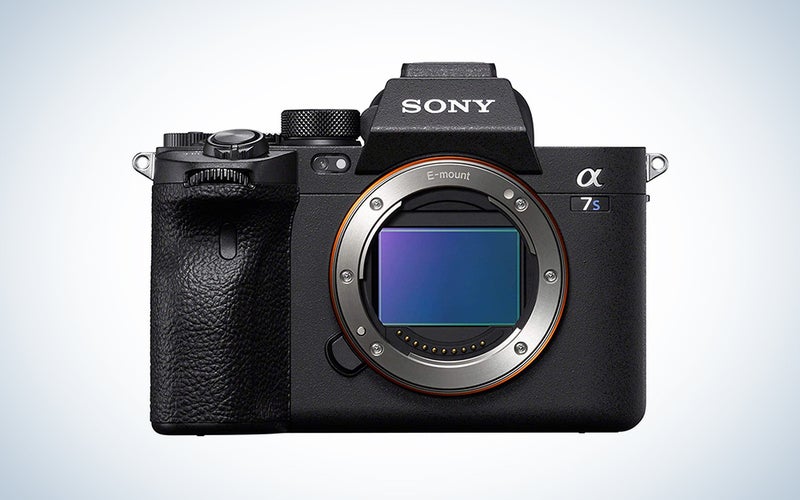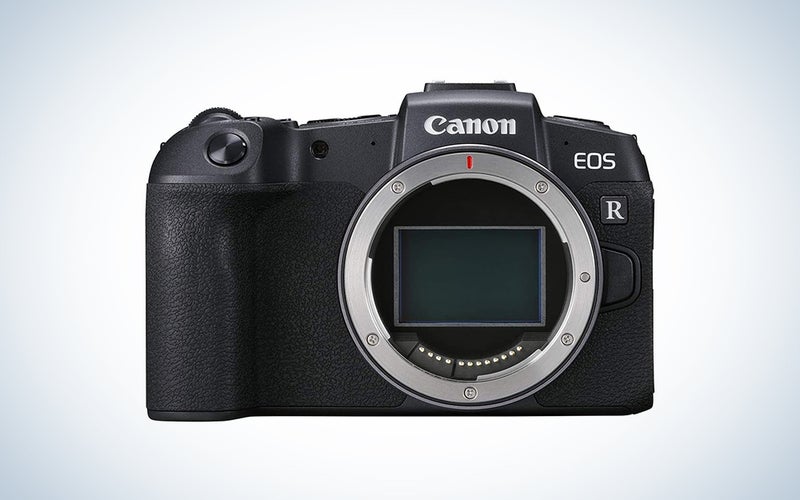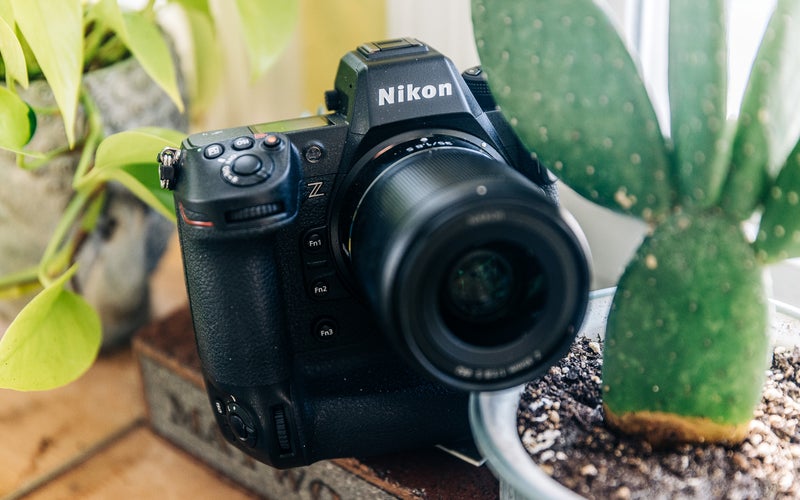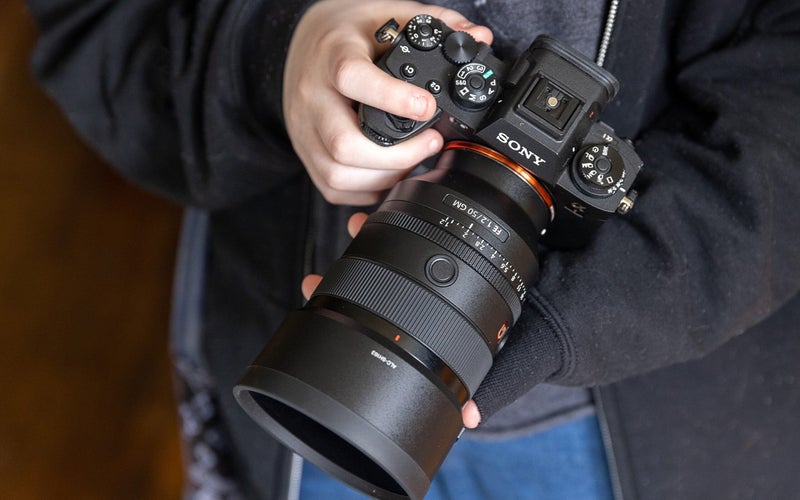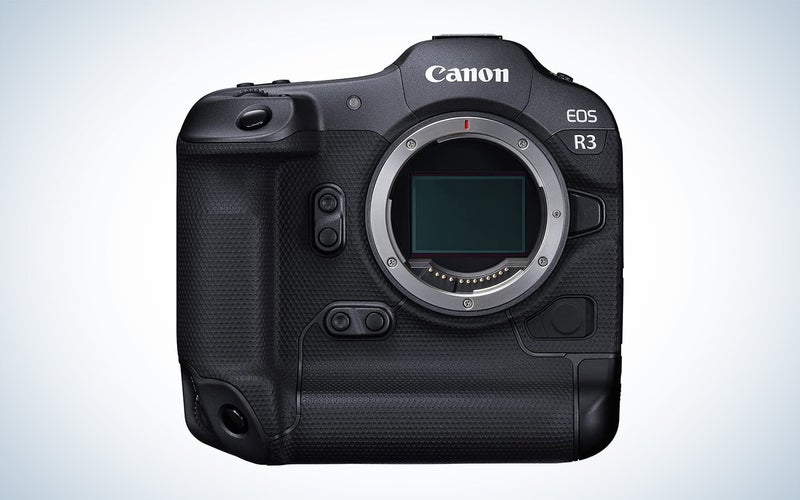We may earn revenue from the products available on this page and participate in affiliate programs. Learn more ›
Sensor size isn’t everything, but full-frame cameras do have their advantages. A little extra silicon real estate certainly doesn’t hurt when it comes to image quality and depth of field. That’s what makes full-frame cameras so popular with photographers and video shooters. The phrase “full-frame” means that the sensor inside the camera is the same size as a single photo taken on 35mm film. This familiar size means that standard lenses will produce the angle of view you’d expect if you were shooting with an older film camera. Full-frame cameras are not all created equal, though; different options are best for different situations and types of photographers. Below, you’ll find the best full-frame cameras for a range of use cases so you can choose one that fits your needs.
- Best overall: Canon EOS R6 Mark II
- Best upgrade from a smartphone: Sony a7C II
- Best DSLR: Nikon D850
- Best for beginners: Nikon Z5
- Best for video: Sony a7S III
- Best budget: Canon EOS RP
- Best full-sized for pros: Nikon Z9
- Best regular-sized for pros: Sony A1
- Best for sports: Canon EOS R3
How we chose the best full-frame cameras
The writers and editors at Popular Photography have been testing and reviewing cameras for decades and have had hands-on time with almost every camera on this list. This group was compiled through a mix of first-hand testing, spec comparisons, editorial reviews, and user feedback. We started with a roster in the dozens and whittled it down to these selections based on features like autofocus performance, resolution, video capabilities, price, and more.
The best full-frame cameras: Reviews and Recommendations
Just because a camera has a big chip inside doesn’t make it a winner. We curated this list of the best full-frame cameras by selecting models best suited for different kinds of photographers and content creators. And while upgrading to full-frame is certainly no replacement for hard work and talent, it also doesn’t hurt.
Best overall: Canon EOS R6 Mark II
Abby Ferguson
Why it made the cut: It’s the right balance of size, price, and resolution for the majority of advanced shooters.
Specs
- Resolution: 23.2 megapixels
- Sensor size: Full-frame
- Lens mount: Canon RF
- Image stabilization: Sensor-shift, 5-axis
- Memory card slots: Dual slot: SD/SDHC/SDXC (UHS-II)
- Weight: 1.3 pounds
- Dimensions: 5.4 x 3.9 x 3.5 inches
Pros
- Excellent balance of features
- Advanced video features
- Fantastic image quality
- Tough build
- Great for capturing action and sports
Cons
- Not as many tactile controls as some would like
The Canon EOS R6 Mark II is a fantastic do-it-all camera with a 24.2-megapixel full-frame sensor. It inherited the more expensive EOS R3’s autofocus, though the R6 Mark II won’t match that performance since it doesn’t feature a stacked sensor. Even still, Canon’s Dual Pixel CMOS AF II autofocus is superb, with fast and accurate results. One feature we especially love is the Auto Subject Tracking mode, which means you don’t need to continuously dig in the menus if you shoot a range of subjects. You can even change the sensitivity of when the camera should switch between subjects, which is very handy.
The R6 Mark II sees a significant upgrade from the first iteration in burst shooting. It’s capable of 12 frames per second (fps) with the mechanical shutter and a speedy 40 fps with the electronic shutter. The 40 fps even works with 12-bit raw files, which is impressive. It made photographing fast-action sports such as diving and mountain biking much easier.
Canon built this camera as a hybrid machine, and as such, it offers excellent video specs as well. It’s capable of 4K 60p full-width internal recording, which is oversampled from 6K. It can also handle 6K 12-bit raw external recording. The Detect Only AF keeps focus on your subject, even if they come from or go behind an obstacle like a wall, which results in smoother videos with limited focus shifting.
As we would expect from a Canon camera, the R6 Mark II offers excellent all-around image quality with plenty of dynamic range for more flexibility when editing. It’s a little more expensive than our best beginner pick but packs some compelling features that make it a better fit for high-end video or high-speed sports shooting. If you’re looking for more resolution, you can step up to the Canon EOS R5, which offers 45 megapixels of resolution and more tactile controls, but it also costs considerably more.
To read more about the Canon EOS R6 Mark II, check out our full review.
Best upgrade from a smartphone: Sony a7C II
Sony
Why it made the cut: The simplified layout and lack of viewfinder make it an easy jump from a smartphone, but a huge leap in image quality.
Specs
- Resolution: 33 megapixels
- Sensor size: Full-frame
- Lens mount: Sony E
- Image stabilization: Sensor-shift, 5-axis
- Memory card slots: Single slot: SD/SDHC/SDXC (UHS-II)
- Weight: 1.1 pounds
- Dimensions: 4.9 x 2.8 x 2.5 inches
Pros
- Simple controls
- Compact body
- Excellent image quality
Cons
- More advanced shooters may miss the built-in viewfinder
Searching for the best full-frame cameras for your average person? The Sony a7C II is essentially a more compact version of the ultra-popular Sony a7 IV. It boasts a 30-megapixel image sensor with seven stops of stabilization in an extremely compact body. The small size makes it an ideal choice for world travelers or anyone who doesn’t want to lug around a bulky camera.
The a7C II offers 10 fps continuous shooting with Sony’s hybrid autofocus system, including eye detection. Video shooters will appreciate the 10-bit full-frame 4K 30p video. You can also record 4K up to 60p if you’re okay with a crop. The viewfinder is a bit small, but the 2.36m-dot OLED provides good quality for composing your shots. The one annoyance is the single SD card slot, but setting this fact aside, the Sony a7C II checks all the right boxes for most people.
Best DSLR: Nikon D850
Amazon
Why it made the cut: Nikon’s high-res DSLR can still compete with the best of them.
Specs
- Resolution: 45.7 megapixels
- Sensor size: Full-frame
- Lens mount: Nikon F
- Image stabilization: None
- Memory card slots: Slot 1: SD/SDHC/SDXC (UHS-II), Slot 2: CFexpress Type B / XQD
- Weight: 2.01 pounds
- Dimensions: 5.7 x 4.9 x 3.1 inches
Pros
- High-end sensor with lots of resolution
- Tried-and-true Nikon layout and menu system
- Excellent dynamic range
- Lag-free optical viewfinder
Cons
- Faces fierce competition from Nikon’s high-res mirrorless cameras
Since its release in 2017, the Nikon D850 has pretty much owned the full-frame DSLR camera crown. This 45-megapixel camera combines high resolution with lighting-fast autofocus and up to 9 fps continuous shooting. It’s capable of 4K video recording, an 8K time-lapse mode, and one of the most popular lens mounts in existence. It’s telling that our pick for the best full-frame DSLR is now four years old. The Nikon D850 remains incredibly hard to beat.
Best for beginners: Nikon Z5
Amazon
Why it made the cut: It’s a very affordable way to get into full-frame mirrorless.
Specs
- Resolution: 24.3 megapixels
- Sensor size: Full-frame
- Lens mount: Nikon Z
- Image stabilization: Sensor-shift, 5-axis
- Memory card slots: Dual slot: SD/SDHC/SDXC (UHS-II)
- Weight: 1.3 pounds
- Dimensions: 5.28 x 3.96 x 2.74 inches
Pros
- Affordable
- Compact
- Uses Nikon’s full-frame Z mount, which has lots of new lenses coming
- Two card slots
Cons
- Limited physical controls
Searching for the best camera for beginners? Nikon’s entry-level Z5 is part of the company’s full-frame mirrorless Z-series, aimed directly at beginners. It uses a 24-megapixel image sensor with 4.5 fps continuous shooting, 5-axis in-body image stabilization, 4K video recording, built-in Wi-Fi and Bluetooth, and a high-resolution electronic viewfinder. It even features dual SD card slots for instant backup or extra storage. It’s a great full-frame mirrorless camera to start out on and still gives you plenty of room to grow.
Best for video: Sony a7S III
Amazon
Why it made the cut: The low-resolution sensor works in the A7S III’s favor when it comes to shooting uncropped video and low-light perfomance.
Specs
- Resolution: 12.1 megapixels
- Sensor size: Full-frame
- Lens mount: Sony E
- Image stabilization: Sensor-shift, 5-axis
- Memory card slots: Dual slot: CFexpress Type A / SD (UHS-II)
- Weight: 1.5 pounds
- Dimensions: 5.1 x 3.8 x 3.2 inches
Pros
- Large pixels spread across a full-frame sensor
- Un-cropped video at high-resolutions
- Fantastic low-light performance
Cons
- 12.1-megapixel sensor may underwhelm photographers
Sony’s a7S III was a long time coming, but when it arrived, it became an instant favorite of videographers everywhere. Whether you are creating videos for YouTube or documenting weddings, the a7S III is up for the task. Despite using only a 12-megapixel image sensor, it can shoot 4K video at up to 120fps with 10-bit internal 4:2:2 recording, 16-bit RAW output to an external recorder, and Sony’s top-of-the-line autofocus system. Essentially, you’re trading resolution for phenomenal video performance without springing for a camera that can shoot 8K.
If you want more resolution for photos with strong video performance, the a7 IV is another favorite for content creators. It offers a larger 33-megapixel sensor, giving you more room for cropping and printing large. And it’s capable of up to 4K 60p video. You can check out our full review to learn more about this camera for hybrid shooters.
Best budget: Canon EOS RP
Amazon
Why it made the cut: It’s hard to find a current-gen full-frame camera for less.
Specs
- Resolution: 26.2 megapixels
- Sensor size: Full-frame
- Lens mount: Canon RF
- Image stabilization: Digital, 5-axis (video only)
- Memory card slots: Single slot: SD/SDHC/SDXC (UHS-II)
- Weight: 1.07 pounds
- Dimensions: 5.2 x 3.3 x 2.8 inches
Pros
- Very affordable
- Impressive resolution at this price
- Excellent image quality
- Uses Canon’s RF mount
Cons
- One memory card slot
- Awkward rocker controls
The Canon EOS RP is the most affordable full-frame camera on the market. And yet it still delivers the goods, including a 26-megapixel image sensor, 5 fps continuous shooting, Dual Pixel CMOS AF autofocus, 4K video, Wi-Fi and Bluetooth connectivity, and a 2.36m-dot electronic viewfinder. Conspicuously absent at this price point are in-body image stabilization and dual card slots, but with a price tag of just $999, there are some tradeoffs with resolution and slowed-down autofocus.
Best full-sized for pros: Nikon Z9
Stan Horaczek
Why it made the cut: Nikon’s flagship mirrorless camera captures high-resolution photos at super-high speeds.
Specs
- Resolution: 45.7 megapixels
- Sensor size: Full-frame
- Lens mount: Nikon Z
- Image stabilization: Sensor-shift, 5-axis
- Memory card slots: Dual slot: CFexpress Type B / XQD
- Weight: 2.9 pounds
- Dimensions: 5.9 x 5.9 x 3.6 inches
Pros
- Super-fast captures
- High-resolution sensor
- Tons of tactile controls
- Silent operation
- Advanced metering and AF tracking
- Tons of customizability
Cons
- Big
- Expensive
Nikon decided it wasn’t interested in moderation when it designed the relatively absurd Z9. It’s a mirrorless camera without any kind of mechanical shutter. Its sensor reads out super fast, so it can capture huge bursts at 20 fps with full AF tracking and AE metering going the whole time. Plus, it’s built like a tank with lots of weather sealing, so it’s meant to last for years, even under harsh punishment. If you can find one in stock and afford it, there’s literally no situation in which this camera body would be out-classed.
Best regular-sized for pros: Sony A1
Popular Photography
Why it made the cut: It looks like a regular A7 camera, but Sony stuffed this pro camera to the gills with features.
Specs
- Resolution: 50.1 megapixels
- Sensor size: Full-frame
- Lens mount: Sony E
- Image stabilization: Sensor-shift, 5-axis
- Memory card slots: Dual slot: CFexpress Type A / SD (UHS-II)
- Weight: 1.6 pounds
- Dimensions: 5.07 x 3.81 x 2.74 inches
Pros
- Packs pro features into a normal-sized mirrorless body
- Super-fast capture
- High-resolution sensor
- Advanced AF settings
Cons
- Clunky menu system
- Expensive
Sony’s flagship mirrorless camera takes a similar approach to Nikon’s Z9 in that it can do pretty much anything you’d ever want it to do. Its 50-megapixel sensor reads out super fast, which allows it to produce long bursts of 30 fps captures at full resolution. The a1 is also capable of 8K 30p and 4K 120p video in 10-bit, making it an excellent tool for videographers. Despite its decidedly professional stats, it packs into the shape of a typical A7-series mirrorless camera rather than adding a heavy vertical grip. It’s one of the best full-frame cameras we’ve ever used.
Best for sports: Canon EOS R3
Canon
Why it made the cut: This perfectly balanced body puts the emphasis on speed at every step of the process.
Specs
- Resolution: 24.1 megapixels
- Sensor size: Full-frame
- Lens mount: Canon RF
- Image stabilization: Sensor-shift, 5-axis
- Memory card slots: Slot 1: CFexpress Type B, slot 2: SD/SDHC/SDXC (UHS-II)
- Weight: 2.2 pounds
- Dimensions: 5.9 x 5.6 x 3.4 inches
Pros
- Unmatched AF tracking
- Fantastic build quality
- Perfect resolution for its purpose
Cons
- Eye AF feature doesn’t feel super useful in some instances
Rather than trying to ratchet up the speed on its high-resolution cameras, Canon purpose-built a camera for sports photographers. It features a super-rugged coating on the outside and a deep grip that makes it very easy to hold, even when there’s a huge lens attached to the front. The autofocus menus have pages and pages of customizability, but the people and object tracking works fantastically right out of the box. Its viewfinder is big and bright, thanks partly to the Eye AF system, which tracks your eye to determine where to focus. If you’re a sports shooter, We think this is the best camera you can buy at the moment.
What to look for when shopping for the best full-frame cameras
Even though all these cameras share the same-sized sensor, they differ in a wide variety of ways. Here are some things to consider when shopping for the best full-frame cameras.
Resolution
Just because these cameras come toting large sensors doesn’t necessarily mean they’re going to be packed with pixels. Some cameras, like the Sony A7S III, opt for a lower 12-megapixel resolution to employ bigger pixels that can pull in more light. The sweet spot for most people likely falls somewhere in the 20-30-megapixel range. That’s plenty of resolution for most things (even large prints), but won’t require an army of memory cards or a super-powerful computer at home when it’s time to edit your shots.
Camera design & layout
You’re going to become very familiar with your camera over time, but a solid layout with intuitive controls can speed up that learning process. If you’re already using a company’s cameras, you’ll likely have an easier time moving to one of their new models than if you switch manufacturers. Some photographers—typically those on the more advanced side of things—prefer more tactile controls like buttons and dials. They speed up the process of navigating the camera because they allow for setting changes without the need to dig into an on-screen menu. Beginners or those moving from smartphone photography may prefer the on-screen menus because they’re more familiar. There’s no right or wrong answer in this case. It all comes down to preference.
Rotating screen
Most full-frame cameras come toting advanced screens that measure three inches or more on the diagonal. Some, however, offer displays that flip around in various directions. While you may not think you need this feature, it can be extremely handy for shooting videos or even taking the occasional selfie. Even if those situations won’t come up very often for you, a rotating screen can provide opportunities to shoot carefully framed shots at very odd and unique angles. It’s a tool you’ll likely use more than you think.
ISO range
Camera companies sometimes boast of maximum sensitivity settings that climb up to over 100,000. Those are impressive on paper, but the real world offers a much different view. Even high-end digital cameras typically top out around ISO 6,400 when it comes to getting usable photos. Sometimes, you can go up to 10,000 and beyond, but expect a ton of grain and less-than-accurate colors. When I go that high, I usually assume I’m going to convert to black-and-white because monochrome images deal with noise much better.
Memory card slots
If you’re moving up to a full-frame body because you want to start doing professional work, consider a body with two memory card slots. That way, you can shoot two copies of every photo in real-time in case one of the cards gets damaged or corrupted. Charging people for photos and then losing them because you didn’t have a real-time backup is a total amateur move and can seriously damage your reputation. You will hear people tell you that they shoot with a single card “all the time,” and it’s always “fine,” but it only takes one catastrophe to cause havoc.
FAQs
Q: What is a full-frame camera?
The phrase “full-frame” means that the sensor inside the camera is the same size as a single photo taken on 35mm film. It’s roughly 36mm wide and 24mm tall. This familiar size means that standard lenses will produce the angle of view you’d expect if you were shooting with an older film camera. A 50mm lens feels like a 50mm lens on a full-frame camera. Smaller sensor cameras, like those that use APS-C sensors, only capture part of the image circle, which makes the images appear more zoomed-in. You don’t get the full width out of your lenses. Because there’s less room on the sensor, APS-C cameras typically can’t quite match the image quality found in the best full-frame cameras.
Q: What should I look for in a full-frame camera?
When shopping for the best full-frame mirrorless camera, think carefully about all the ways that you plan to use it. Is this camera for travel? Weddings? Sports? Will you be shooting both photos and video or only using it for still photography? Is it going to form the backbone of your business, or are you a weekend warrior?
Once you’ve answered these questions, you’ll know what to prioritize. For travel, think about size and portability. For weddings, you’ll want higher resolution and great low-light performance. And for sports, you need speed and lots of it. And if you’re going to be shooting video, you’ll probably want a mirrorless full-frame camera that can shift seamlessly between the two modes.
Q: Do full-frame cameras take better pictures?
Yes and no. All else being equal, the larger sensor inside a full-frame camera can gather more light than a smaller sensor, which makes it easier to take great pictures in low-light situations. Full-frame cameras also tend to benefit from a wider selection of high-quality lenses, which has a huge impact on the quality of your photos. And, of course, the wider, uncropped view makes it much easier to capture ultra-wide angle imagery without resorting to extreme lenses.
All of this can technically produce “better pictures” than a camera with a smaller sensor, but a camera doesn’t automatically produce better photos just because it uses a full-frame sensor. That’s still up to the photographer.
Q: How can you tell if a camera is full-frame?
When you’re shopping for a full-frame mirrorless camera or DSLR, look for the term “full-frame” on the spec sheet under “Camera Format” or “Image Sensor Type.” If, instead, you see the term “APS-C” or “Micro Four Thirds,” you’re not looking at a full-frame camera.
Final thoughts on the best full-frame cameras
- Best overall: Canon EOS R6 Mark II
- Best upgrade from a smartphone: Sony a7C II
- Best DSLR: Nikon D850
- Best for beginners: Nikon Z5
- Best for video: Sony a7S III
- Best budget: Canon EOS RP
- Best full-sized for pros: Nikon Z9
- Best regular-sized for pros: Sony A1
- Best for sports: Canon EOS R3
The world of photography equipment can be tricky to navigate alone. With so many options to choose from, finding the best full-frame cameras for you can be a challenge. Gone are the days when there were only a few choices, all of them prohibitively expensive and all of them aimed at professionals. But if you take the time to evaluate your needs as a photographer, educate yourself on the core features that tend to drive up the price of a camera, and explore some of the top picks above, you can confidently make the leap to full-frame and take your photography to the next level.
Why trust us
PopPhoto has a long history of delivering the opinions of some of the sharpest and most prolific camera dorks the world has to offer. Since 1937, we’ve been reviewing cameras, providing wisdom from well-known photographers, and generally just nerding out about all that goes into making great pictures. Our current crop of writers and editors have decades of professional photography and camera writing experience among them. Collectively, we’ve probably shot with just about every camera and lens combo you can imagine—as well as some obscure stuff you may not even know about. Remember the Casio Tryx folding camera? PopPhoto does.
We also get that buying a camera is a big decision, which is why we’re dedicated to helping folks choose the right one (or, in our case “ones”) for their needs. Case in point: Handing over top dollar for an expensive rig may leave you unsatisfied if it doesn’t fit your preferred shooting style. Sure, a $6,000 sports-oriented DSLR can capture landscapes, but do you really need to do it at 30 frames-per-second? No, you don’t.
